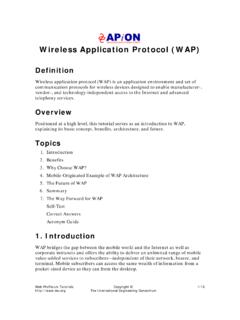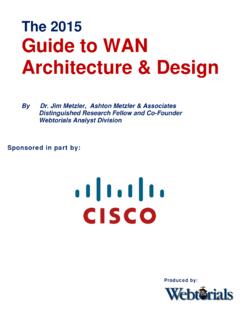Transcription of Introducing Network Design Concepts - Pearson
1 CHAPTER 1 Introducing Network Design ConceptsObjectivesUpon completion of this chapter, you should be able to answer the following questions: What are the benefits of a hierarchal networkdesign? What is the Design methodology used by Network designers? What are the Design considerations for the core,distribution, and access layers? What are the Design considerations for the Network enterprise edge? What are the Design considerations that must bemet to support remote workers? What are the Design considerations for supportingenterprise wireless and/or data center/server farms?Key TermsThis chapter uses the following key terms. You can find the definitions in the Enterprise Architecturespage 5deterministic Network page 5top-down approachpage 7content networkingpage 8storage networkingpage 8network backbonepage 9virtual private networks (VPN)page 9extranetpage 9multilayer switchespage 11load balancingpage 11 Enhanced Interior Gateway Routing Protocol(EIGRP)page 11 Open Shortest Path First (OSPF) Protocolpage 11 Spanning Tree Protocol (STP)page 11full-meshpage 11partial-meshpage 11hot-swappablepage 13uninterruptible power supply (UPS)page 13convergence timepage 14switch block page 17 Rapid Spanning Tree Protocol (RSTP)page 18access control lists (ACL)page 19dynamic ACLpage 20reflexive ACLpage 20time-based ACLpage 20 Intermediate System-to-Intermediate System (IS-IS)Protocolpage 21 Power-over-Ethernet (PoE)
2 Page 23failoverpage 24network access controlpage 30security policy page 30server farmspage 30data centers page 30storage-area networks (SAN)page 32denial-of-service (DoS)page 32demilitarized zone (DMZ)page 33 Rapid Spanning Tree Protocol Plus (RSTP+) page 34wireless LAN (WLAN)page 34 Wired Equivalent Privacy (WEP)page 37Wi-Fi Protected access (WPA)page 37service set identifier (SSID)page 37cell- switched networkspage 40 Asynchronous Transfer Mode (ATM)page 40service level agreements (SLA)page 4/3/08 6:23 PM Page 1 Network designers ensure that our communications networks can adjust and scale to the demands fornew support our Network -based economy, designers must work to create networks that are availablenearly 100 percent of the time. Information Network security must be designed to automatically fend off unexpected security incidents. Using hierarchical Network Design principles and an organized Design methodology, designers createnetworks that are both manageable and Network Design BasicsThe sections that follow cover the basics of Network Design with regard to the following Concepts : Network Design overview The benefits of a hierarchical Network Design Network Design methodologyNetwork Design Overview Computers and information networks are critical to the success of businesses, both large and connect people, support applications and services , and provide access to the resources that keepthe businesses running.
3 To meet the daily requirements of businesses, networks themselves are becom-ing quite RequirementsToday, the Internet-based economy often demands around-the-clock customer service. This means thatbusiness networks must be available nearly 100 percent of the time. They must be smart enough toautomatically protect against unexpected security incidents. These business networks must also beable to adjust to changing traffic loads to maintain consistent application response times. It is nolonger practical to construct networks by connecting many standalone components without carefulplanning and Design . Building a Good NetworkGood networks do not happen by accident. They are the result of hard work by Network designers andtechnicians, who identify Network requirements and select the best solutions to meet the needs of steps required to Design a good Network are as follows:Step the business goals and technical the features and functions required to meet the needs identified in Step a Network -readiness a solution and site acceptance test a project and Supporting Computer Networks, CCNA Discovery Learning GuideHow 4/3/08 6:23 PM Page 2 After the Network requirements have been identified, the steps to designing a good Network are fol-lowed as the project implementation moves users generally do not think in terms of the complexity of the underlying Network .
4 Theythink of the Network as a way to access the applications they need, when they need them. Network RequirementsMost businesses actually have only a few requirements for their Network : The Network should stay up all the time, even in the event of failed links, equipment failure, andoverloaded conditions. The Network should reliably deliver applications and provide reasonable response times from anyhost to any host. The Network should be secure. It should protect the data that is transmitted over it and data storedon the devices that connect to it. The Network should be easy to modify to adapt to Network growth and general business changes. Because failures occasionally occur, troubleshooting should be easy. Finding and fixing a problemshould not be too Design GoalsWhen examined carefully, these requirements translate into four fundamental Network Design goals: Scalability: Scalable Network designs can grow to include new user groups and remote sites andcan support new applications without impacting the level of service delivered to existing users.
5 Availability: A Network designed for availability is one that delivers consistent, reliable perform-ance, 24 hours a day, 7 days a week. In addition, the failure of a single link or piece of equipmentshould not significantly impact Network performance. Security: Security is a feature that must be designed into the Network , not added on after the net-work is complete. Planning the location of security devices, filters, and firewall features is criticalto safeguarding Network resources. Manageability: No matter how good the initial Network Design is, the available Network staffmust be able to manage and support the Network . A Network that is too complex or difficult tomaintain cannot function effectively and Benefits of a Hierarchical Network Design To meet the four fundamental Design goals, a Network must be built on an architecture that allows forboth flexibility and growth. Hierarchical Network DesignIn networking, a hierarchical Design is used to group devices into multiple networks.
6 The networks areorganized in a layered approach. The hierarchical Design model has three basic layers: Core layer: Connects distribution layer devices Distribution layer: Interconnects the smaller local networks access layer: Provides connectivity for Network hosts and end devicesChapter 1: Introducing Network Design 4/3/08 6:23 PM Page 3 Hierarchical networks have advantages over flat Network designs. The benefit of dividing a flat networkinto smaller, more manageable hierarchical blocks is that local traffic remains local. Only traffic destinedfor other networks is moved to a higher layer. Layer 2 devices in a flat Network provide little opportunity to control broadcasts or to filter undesirabletraffic. As more devices and applications are added to a flat Network , response times degrade until thenetwork becomes unusable. Figures 1-1 and 1-2 show the advantages of a hierarchical Network designversus a flat Network 1-1 Flat Network4 Designing and Supporting Computer Networks, CCNA Discovery Learning GuideFlat switched NetworkOne Large Broadcast DomainHierarchical NetworkCoreAccessDistributionThree Separate Broadcast DomainsFigure 1-2 Hierarchical 4/3/08 6:23 PM Page 4 Modular Design of Cisco Enterprise ArchitecturesThe Cisco Enterprise Architectures(see Figure 1-3) can be used to further divide the three-layer hier-archical Design into modular areas.
7 The modules represent areas that have different physical or logicalconnectivity. They designate where different functions occur in the Network . This modularity enablesflexibility in Network Design . It facilitates implementation and troubleshooting. Three areas of focus inmodular Network Design are as follows: Enterprise campus: This area contains the Network elements required for independent operationwithin a single campus or branch location. This is where the building access , building distribu-tion, and campus core are located. Server farm: A component of the enterprise campus, the data center server farm protects theserver resources and provides redundant, reliable high-speed connectivity. Enterprise edge: As traffic comes into the campus Network , this area filters traffic from the exter-nal resources and routes it into the enterprise Network . It contains all the elements required forefficient and secure communication between the enterprise campus and remote locations, remoteusers, and the 1-3 Cisco Enterprise ArchitecturesChapter 1: Introducing Network Design Concepts5 EnterpriseTeleworkerEnterpriseBranchEnte rprise EdgeWAN and InternetISP AISP BFrame Relay/ATM/MetroEthernet/.
8 PSTNC isco Enterprise ArchitecturesE-CommerceInternet ConnectivityWAN and MetroEthernet Site-to-Site VPNR emote Accessand VPNE nterprise CampusBuilding AccessBuilding DistributionCampus CoreServer Farm andData CenterNetworkManagementThe modular framework of the Cisco Enterprise Architectures as depicted in Figure 1-4 has the followingdesign advantages: It creates a deterministic networkwith clearly defined boundaries between modules. This providesclear demarcation points so that the Network designer knows exactly where the traffic originatesand where it flows. It eases the Design task by making each module independent. The designer can focus on theneeds of each area 4/3/08 6:23 PM Page 5 It provides scalability by allowing enterprises to add modules easily. As Network complexitygrows, the designer can add new functional modules. It enables the designer to add services and solutions without changing the underlying Network 1-4 Enterprise Campus6 Designing and Supporting Computer Networks, CCNA Discovery Learning GuideIPTeleworkerHome PCFrameRelayPSTNN etworkCampusBackboneInternetTelecommuter RouterUniversalGatewayServer FarmBuilding 1 Building 2 Enterprise EdgeEnterprise CampusFirewallWebServerBranch OfficesRouterInteractive Activity 1-1: Match the Characteristics of the Hierarchal Model and the CiscoEnterprise Architecture ( )In this interactive activity, you match the characteristics of the hierarchal model and the CiscoEnterprise Architecture to their correct location.
9 Use file ia-112 on the CD-ROM that accompaniesthis book to perform this interactive Design MethodologiesLarge Network Design projects are normally divided into three distinct steps:Step the Network the existing the Network topology and 4/3/08 6:23 PM Page 6 Step 1: Identifying Network RequirementsThe Network designer works closely with the customer to document the goals of the project. Figure 1-5depicts a meeting between the designer and the business owner. Goals are usually separated into twocategories: Business goals: Focus on how the Network can make the business more successful Technical requirements: Focus on how the technology is implemented within the networkStep 2: Characterizing the Existing NetworkInformation about the current Network and services is gathered and analyzed. It is necessary to comparethe functionality of the existing Network with the defined goals of the new project.
10 The designer determineswhether any existing equipment, infrastructure, and protocols can be reused, and what new equipmentand protocols are needed to complete the 3: Designing the Network TopologyA common strategy for Network Design is to take a top-down approach. In this approach, the networkapplications and service requirements are identified, and then the Network is designed to support them. When the Design is complete, a prototype or proof-of- concept test is performed. This approachensures that the new Design functions as expected before it is 1-5 Client InteractionChapter 1: Introducing Network Design Concepts7 What business goals do youwant to accomplish with thenetwork upgrade?Our Network designers needto schedule a meeting withyour IT manager to gatherinformation about your currentnetwork common mistake made by Network designers is the failure to correctly determine the scope of thenetwork Design project.












